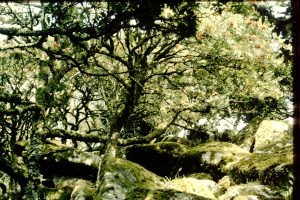 The Prologue of Plague of a Green Man, the second book in my Lady Apollonia West Country Mystery series, opens in a blinding fog on Dartmoor not far from the city of Exeter in Devon in the year 1380. Dartmoor is southwest of the city of Exeter where I lived with my husband four different years in the late 1980’s and in the 1990’s. In 1951 Dartmoor had become the first English national park covering an area of 368 square miles. There are signs of human life on the moor from the Neolithic period or New Stone Age as well as the largest collection of Bronze Age remains in Britain. The climate was warmer in the Bronze Age than in the 14th century, and a good-sized human population had moved into these uplands clearing the forestland for farming. They created tracts of open land which eventually, as the climate cooled, became covered with heather when it was abandoned and no longer cultivated.
The Prologue of Plague of a Green Man, the second book in my Lady Apollonia West Country Mystery series, opens in a blinding fog on Dartmoor not far from the city of Exeter in Devon in the year 1380. Dartmoor is southwest of the city of Exeter where I lived with my husband four different years in the late 1980’s and in the 1990’s. In 1951 Dartmoor had become the first English national park covering an area of 368 square miles. There are signs of human life on the moor from the Neolithic period or New Stone Age as well as the largest collection of Bronze Age remains in Britain. The climate was warmer in the Bronze Age than in the 14th century, and a good-sized human population had moved into these uplands clearing the forestland for farming. They created tracts of open land which eventually, as the climate cooled, became covered with heather when it was abandoned and no longer cultivated.
The centre of Dartmoor is dominated by many towering outcroppings of granite called tors which sit on a granite base of 240 square miles. There are 160 of these tors on Dartmoor. Much of the underground granite is covered by great deposits of peat which absorb water like a huge sponge. Such peat deposits are called bogs, a phenomenon popularised by J. Conan Doyle in The Hound of the Baskervilles. Dartmoor, too, is a wild upland country and being just ten miles from the centre of Exeter, we found it to be a glorious place for hiking and exploring getaways when we were living in Exeter.
Six major rivers flow in various directions towards the sea from their sources in the peat deposits of Dartmoor. All the moor takes its name from the River Dart, one of these six rivers. I use the eastern part of Dartmoor as my setting in the Prologue of Plague of a Green Man when Brandon Landow, the disreputable pardoner in my stories, seeks to meet someone in Grimspound and gets lost in a dense fog so common on Dartmoor. He eventually finds flowing water in the fog and works his way downstream on Wray Brook until he reaches habitation and a church in the village of Lustleigh.
The slopes and valleys around the sides of Dartmoor are often wooded providing a sharp contrast with the central moorland which is open range for grazing sheep, cows, and wild ponies. To negotiate bogs when we were hiking on the moor, Lou and I learned to follow in the footsteps of livestock who always seemed to know where it was safe to walk. A fascinating anomaly in the moorland of Dartmoor is near the village of Two Bridges. It is called Wistman’s Wood and is nine acres of high altitude oak woodland growing out from the granite slabs covering the earth. Wistman’s Wood survives in the shelter of a southwest slope of the moor, and some of its gnarled trees are shown in the picture above.
For more information on Dartmoor, click on
https://en.wikipedia.org/wiki/Dartmoor .
Tags: Chaucer's England, historical fiction, medieval mysteries